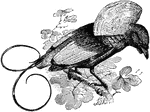
Magnificent Bird of Paradise
"Diphyllodes magnifica, Magnificent Bird of Paradise, has a brown head and under surface, green throat…
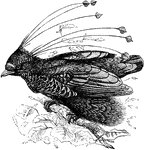
Six-wired Bird of Paradise
"Parotia sexpennis, the Six-wired Bird of Paradise, is bronzy- and purplish-black, having scale-like…
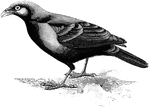
Satin Bower-bird
"Ptilorhynchus violaceus, the Satin Bower-bird, is purplish-black, with much feathered culmen. Female…

A Magpie Sitting on a Tree Branch Looking Down While Surrounded by Other Trees
"The Pica rustica, or Magpie, extends through the Palaearctic Region, and reaches Formosa and North…
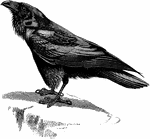
Raven
"Corvus corax, the Raven, are generally black with a purplish or greenish gloss, and frequently with…
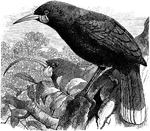
Huia
"Heteralocha acutirostris, the New Zealand Huia, the female has a remarkably long, curved bill, that…

Common Starling
"Our familiar Starling (Sturnus vulgaris) being iridescent black, with buff markings above, and, after…
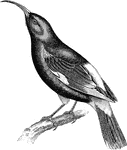
Mamo
"Drepanis pacifica, the Mamo, is black, with golden rump, upper and under tail-coverts, tibiae, and…
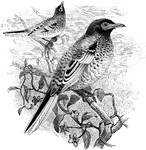
Warty-faced Honey Eater
"Meliphaga phrygia, the Warty-faced Honey-Eater, is yellow and black, spotted and barred below." A.…

Tui
"Prosthemadera novae zealandiae, the Tui, are black and white... two gular patches of curled white filamentary…
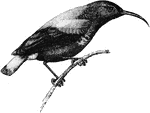
Splendid Sun-bird
"Cinnyris splendidus, the Old World Sun-birds, recalling the non-Passerine Humming-birds by their brilliant…

Tree Creeper
"Certhia familiaris, the Tree Creeper, the coloration of both sexes is brown, black, rufous, buff, grey,…

Sugarbird
"Certhiola flaveola, the Sugar-bird, coloration varies from black, grey, or purplish, relieved by rufous…

Black and White Warbler
"Mniotilta varia, the Black and White Warbler, The general coloration is olive-green, grey, or slaty-blue,…
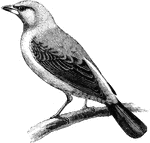
Brazilian Tanager
"Rhamphocoelus brasilius, the Brazilian Tanager, ...are chiefly small in size; the sexes are commonly…

Weaver-bird
"Pyromelaena flammiceps, the Weaver-birds, the coloration of these rather small birds is most striking,…
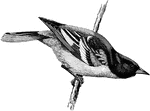
Baltimore Oriole
icterus baltimore, Baltimore Oriole, are glossy black, with yellow, bay, or orange patches-especially…
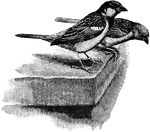
Two House Sparrows, One Looking Down, One looking Straight, Sitting on the Top and Edge of a Structure
"Passer domesticus, House Sparrow, The sexes may be similarly coloured or very different, the hues being…
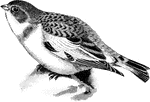
Snow Bunting
" The Snow Bunting (Plectrophenax nivalis), with its black, chestnut, and white plumage, that becomes…

Skeleton of the Limbs and Tail of a Carinate Bird
"Skeleton of the Limbs and Tail of a Carinate Bird. (The skeleton of the body is indicated by dotted…

Archaeopteryx Lithographica
"Archaeornithes is at present represented by but one member, the first undoubted fossil Bird, made known…
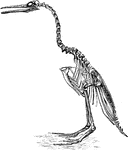
The Restoration of the Hesperornis Regalis
"Hesperornis regalis, (a fossilized restoration) which stood about three feet high, had blunt teeth…

Skeleton Head of a Ichthyornis
"Ichthyornis victor and I. dispar, ...were small forms of about the size of a Partridge, with the habits…
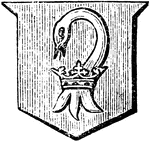
Swan Gorged
"A swan's head erased at the neck, ducally gorged or. GORGED. Any animals, particularly birds, that…
the Windpipe of a Male Red Breasted Merganser
"Trachea or windpipe of the red breasted merganser, Mergus serrator, about half natural size, viewed…
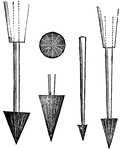
Egg Drills are Special Tools Used for Preparing and Blowing Eggs
"Figure 4 - egg-drills, different sizes. Steel implements with a sharp-pointed conical head of rasping…
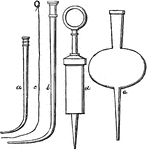
Several Special Instruments Used in the Process of Egg Blowing
"Figure 5-Instruments for blowing eggs; a,b, blow-pipes, 1/2 natural size; c, wire for cleansing them;…

Scissors, Knives, and Forceps Used for Egg Blowing
"Fig. 6- scissors, knives, and forceps, 1/2 natural size." Elliot Coues, 1884 These items may be used…

Hooks Used in the Process of Egg Blowing for the Purpose of Extracting Embryos
"Figure 7-hooks for extracting embryos, natural size; a,b,c, plain hooks; d, bill-hook, having cutting…
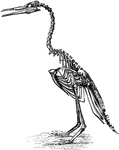
Restoration of Hesperornis regalis
"Hesperornis regalis, (a fossilized restoration) which stood about three feet high, had blunt teeth…
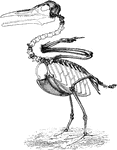
Restoration of Ichthyornis
"Ichthyornis, though the wings are well developed, with fused metacarpals, and the sternum is keeled,…
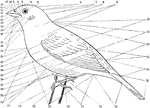
Topography of a Bird
"fig. 25 - Topography of a Bird. 1, forehead (frons). 2, lore. 3, circumocular region. 4, crown (vertex).…
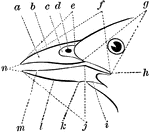
The Parts of a Bird Bill
"Fig. 26 - Parts of a Bill. a, side of upper mandible; b, culmen; c, nasal fossa; d, nostril; e(see…
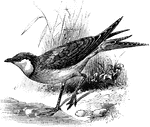
Collared Pratincole
"Common Glareole or Pratincole (Glareola pratincola). GLAREOLA. A remarkable genus of birds, typical…
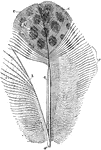
Feather from a Argus Pheasant
"Fig. 19 - A partly pennaceous, partly plumulaceous feather, from Argus pheasant; after Nitzsch. ad,…

Structure of a Feather
"Fig. - 20 - Two barbs, a, a, of a vane, bearing anterior, b, b, and posterior, c, barbules; enlarged;…
Single Barbule
"Fig. 21. -A single barbule, baring barbicels and hooklets; magnified; after Nitzsch. ...barbicels (another…

Barbs
"The arrangement shown in fig. 22, where a, a, a, a, are four barbs in transverse section, viewed from…
A Feather from the Tail of a Kingbird
"Fig. 23 - A feather from the tail of a kingbird, Tyrannus carolinensis, almost entirely pennaceous;…

Pterylosis of Cypselus Apus
"Fig. 24. - Pterylosis of Cyoselus apus, drawn by Coues after Nitzsch; right hand upper, left hand lower,…

The Bones of the Right Wing of a Duck
"Fig 27. - Bones of the right wing of a duck, Clangula islandica, A, shoulder, omos; B, elbow, ancon;…
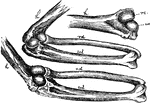
Mechanism of the Elbow-Joint
"Fig. 28. - Mechanism of elbow-joint. ..., where rc and uc show respectively the size, shape, and position…

The Wing Bones of a Young Grouse
"Fig. 29., from a young grouse (Centrocercus urophasianus, six months old), is designed to show the…
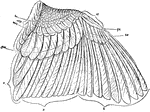
Feathers of a Sparrow's Wing
"Fig. 30., Feathers of a sparrow's wing. pc, covers of the primaries; msc, median upper secondary coverts;…
Red Shafted Woodpecker Ulna
"Fig. 31. - Ulna of Colaptes mexicanus, showing points of attachment of the secondaries. (Dr. R. W.…

Lyre-bird
"The Lyre-bird of Australia, Menura superba, to show the unique lyrate shape of the tail." "... the…
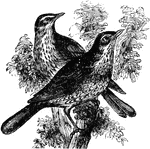
European Redwing
Two European Redwing birds sitting on a tree branch. These song birds are usually brown with darker…

Robin
"Robin: Upper parts slate-color, with a shade of olive. Head black, the eyelids and a spot before the…

Bird Skulls
"Fig. 114. -Skulls of Turdidae and Sylvicolidae, nat. size; after Shufeldt. A, Oroscoptes montanus;…

Wood Thrush
"Wood Thrush. Upper parts, including the surface of the closed wings, tawny-brown, purest and deepest…
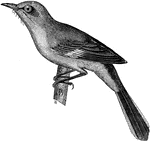
Mockingbird
"Mocking-Birds. Bill much shorter than head, scarcely curved as a whole, but with gently-curved commissure,…

Catbird
"Cat-Bird. Slate-gray, paler and more grayish-plumbeous below; crown of head, tail, bill, and feet black.…
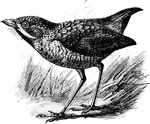
Antpitta
"Grallaria rex. GRALLARIA. A genus of formicarian passerine birds, a leading group of South American…
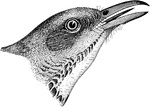
Brown Thrasher
"Upper parts uniform rust-red, with a bronzy lustre. Concealed portions of quills fuscous. Greater the…

Bow-Billed Thrasher
"Above, grayish-brown, nearly uniform; wing- coverts and quills with slight whitish edging, the edge…

Arizona Thrasher
"Bill shorter than head, comparatively stout at base, very acute at tip, the culmen quite convex, the…
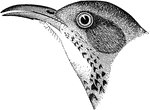
St. Lucas Thrasher
"Upper parts uniform ashy-brown; wings and tail similar, but rather purer and darker brown, the former…

California Thrasher
"No spots anywhere; wings and tail without decided barring or tipping. Bill as long as the head or longer,…

Crissal Thrasher
"Brownish-ash, with a faith olive shade, the wings and tail purer and darker fuscous, without white…
